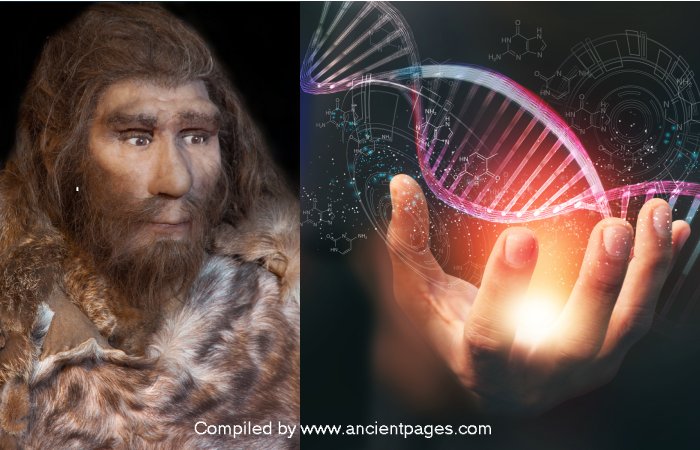Jan Bartek – AncientPages.com – Modern humans migrated to Eurasia 75,000 years ago, where they encountered and interbred with Neanderthals. A new study published in the journal Current Biology shows that at this time Neanderthals were already carrying human DNA from a much older encounter with modern humans.

The Penn-led research team, including collaborators from Addis Ababa University, the University of Botswana, Fudan University, Hubert Kairuki Memorial University, and the University of Yaoundé, showed that an ancient lineage of modern humans migrated to Eurasia over 250,000 years ago where they interbred with Neanderthals. Over time, these humans died out, leaving a population with predominantly Neanderthal ancestry.
“We found this reflection of ancient interbreeding where genes flowed from ancient modern humans into Neanderthals,” says Alexander Platt, a senior research scientist in the Perelman School of Medicine and one of the study’s first authors. “This group of individuals left Africa between 250,000 and 270,000 years ago. They were sort of the cousins to all humans alive today, and they were much more like us than Neanderthals.”
The team arrived at this conclusion by comparing a Neanderthal genome with a diverse set of genomes from modern indigenous populations in sub-Saharan Africa.
“This study highlights the importance of including ethnically and geographically diverse populations in human genetics and genomic studies,” says Sarah Tishkoff, a Penn Integrates Knowledge University professor at Penn and senior author on the work.
Because most Neanderthal-human interbreeding is thought to have occurred in Eurasia, not in Africa, Neanderthal ancestry is expected to be limited in sub-Saharan Africa; however, a recent study made the puzzling observation that several sub-Saharan populations contain chunks of DNA that resemble Neanderthal DNA. The study was unable to determine how this Neanderthal-like DNA entered these populations, whether it originated from modern humans who had migrated from Africa, interbred with Neanderthals in Eurasia, and then returned, or whether it was the result of an earlier encounter between Neanderthals and humans.
Because the study relied on a limited number of genomes from the 1,000 Genomes Project, all of which share a relatively recent common ancestry in Central and Western Africa, it was also unclear whether Neanderthal-like DNA is widespread among sub-Saharan populations.
To better understand how widespread these Neanderthal-like DNA regions are across sub-Saharan Africa and to elucidate their origins, Tishkoff’s team leveraged a genetically diverse set of genomes of 180 individuals from 12 different populations in Cameroon, Botswana, Tanzania, and Ethiopia. For each genome, the researchers identified regions of Neanderthal-like DNA and looked for evidence of Neanderthal ancestry.
Then, they compared the modern human genomes to a genome belonging to a Neanderthal who lived approximately 120,000 years ago. For this comparison, the team developed a novel statistical method that allowed them to determine the origins of the Neanderthal-like DNA in these modern sub-Saharan populations, whether they were regions that Neanderthals inherited from modern humans or regions that modern humans inherited from Neanderthals and then brought back to Africa.
They found that all of the sub-Saharan populations contained Neanderthal-like DNA, indicating that this phenomenon is widespread. In most cases, this Neanderthal-like DNA originated from an ancient lineage of modern humans that pᴀssed their DNA on to Neanderthals when they migrated from Africa to Eurasia around 250,000 years ago. As a result of this modern human-Neanderthal interbreeding, approximately 6% of the Neanderthal genome was inherited from modern humans.
In some specific sub-Saharan populations, the researchers also found evidence of Neanderthal ancestry that was introduced to these populations when humans bearing Neanderthal genes migrated back into Africa. Neanderthal ancestry in these sub-Saharan populations ranged from 0 to 1.5%, and the highest levels were observed in the Amhara from Ethiopia and Fulani from Cameroon.
To try to understand whether carrying modern human DNA was helpful or harmful when introduced into the Neanderthal genome, the researchers also investigated where these chunks of modern human DNA were located. To try to understand whether carrying modern human DNA was helpful or harmful, the researchers also investigated where these chunks of modern human DNA were located within the Neanderthal genome.
They found that most of the modern human DNA was in noncoding regions of the Neanderthal genome, indicating that modern human gene variants were being preferentially lost from coding sections of the genome, which suggests that having modern human genes in a Neanderthal background is detrimental to fitness.
This is similar to what is seen in modern humans, where natural selection has slowly been removing Neanderthal genes from modern human populations. “So a Neanderthal allele might work great in Neanderthals, but you plop it into a modern human genome and it causes problems. Both modern humans and Neanderthals slowly rid themselves of the alleles of the other group,” Platt says.
“In the almost 500,000 years between the ancestors of Neanderthals splitting off from the ancestors of modern humans and these other modern humans being reintroduced to Neanderthal populations, we had become such different organisms that, although we were still able to interbreed quite readily, the hybrids didn’t work so well, which means we were very far along the path to becoming distinct species.”
This research opens new avenues for exploring human evolution by identifying a genetic reference of a population that occupies a part of the human family tree that had previously been lacking from the genomic and fossil record.
“Discovering this ancient lineage of modern humans is really exciting for future research because it gives us a different lens to look at human evolution,” says Daniel Harris, a postdoctoral research fellow in the Perelman School of Medicine and the study’s other first author. “Because we don’t have DNA sequences from modern human fossils from that long ago, identifying these sequences will shed light on very early modern human evolution in Africa.”
The study was published in the journal Current Biology
Written by Jan Bartek – AncientPages.com Staff Writer





